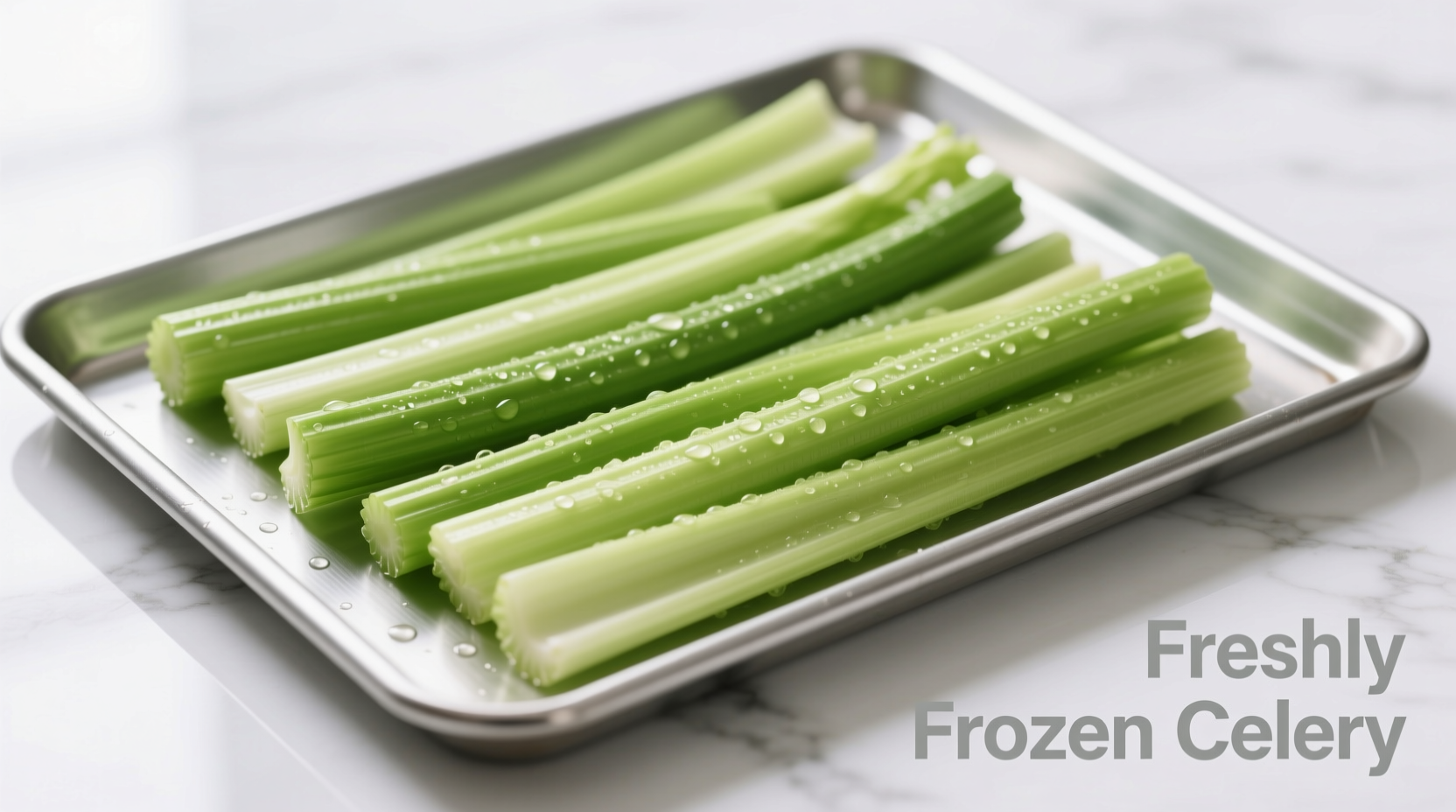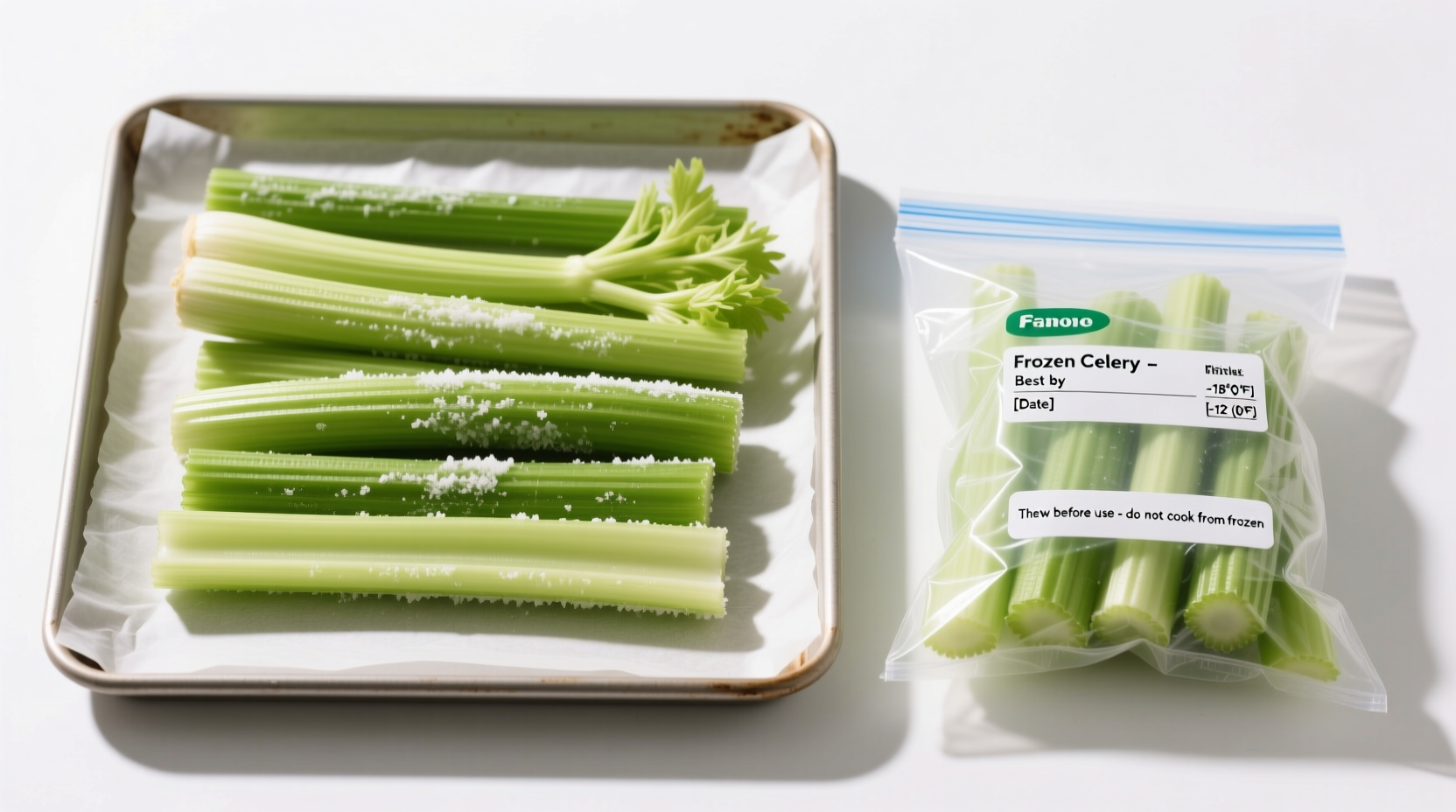Why Freezing Celery Makes Perfect Sense
Nothing's more frustrating than watching crisp celery turn limp in your refrigerator drawer. Freezing preserves celery's flavor and nutrients when done correctly, saving you money and reducing food waste. According to the USDA Food Safety and Inspection Service, proper freezing maintains vegetable quality by slowing enzyme activity that causes spoilage (Freezing and Food Safety). When you learn how to freeze celery the right way, you'll always have this versatile vegetable ready for soups, stews, and stocks.
Choosing Your Freezing Method: Blanching vs. No-Blanch
Understanding your cooking needs determines the best approach for how to freeze celery long term. Professional chefs typically recommend blanching for maximum quality retention, while quick-freeze methods work well for immediate-use applications.
| Method | Best For | Shelf Life | Texture After Thawing |
|---|---|---|---|
| Blanching Method | Long-term storage (6-12 months) | 10-12 months | Firm, ideal for cooking |
| No-Blanch Method | Short-term use (1-3 months) | 1-3 months | Softer, best for cooked dishes |
Step-by-Step: How to Freeze Celery Properly
Preparation Phase: Setting Up for Success
Start with fresh, crisp celery stalks. Wash thoroughly under cold running water, using a vegetable brush to remove any dirt from between the ribs. Trim both ends and separate the stalks. Cut into your desired sizes—typically 1/2-inch pieces for soups or sticks for snacks. The National Center for Home Food Preservation emphasizes that proper preparation prevents freezer burn and maintains quality (Freezing Vegetables).
Blanching Method: Professional Quality Results
Blanching stops enzyme activity that causes flavor and texture degradation. Here's how to freeze celery using this superior method:
- Bring a large pot of water to rolling boil
- Prepare an ice bath in a large bowl
- Submerge celery pieces in boiling water for exactly 3 minutes
- Immediately transfer to ice bath for same duration to stop cooking
- Drain thoroughly and pat completely dry with clean towels
- Spread in single layer on baking sheet and freeze 1-2 hours
- Transfer to airtight freezer bags, removing as much air as possible
- Label with date and contents before returning to freezer

No-Blanch Method: Quick Freezing Solution
When you need to freeze celery fast without specialized equipment:
- Cut celery into uniform pieces
- Spread in single layer on parchment-lined baking sheet
- Place in freezer for 1-2 hours until solid
- Transfer to freezer bags or containers
- Remove excess air and seal tightly
- Label with date for reference
Freezing Timeline and Quality Preservation
Understanding how frozen celery degrades over time helps you maximize its usability. This timeline shows quality changes based on storage conditions:
| Time Period | Blanched Celery | Unblanched Celery |
|---|---|---|
| 0-3 months | Excellent flavor and texture | Good flavor, slightly softer texture |
| 3-6 months | Very good quality, minimal changes | Noticeable texture changes, still usable |
| 6-12 months | Good for cooking, slight flavor loss | Significant quality loss, limited use |
| 12+ months | Edible but diminished quality | Not recommended |
Using Frozen Celery Effectively
Knowing how to freeze celery is only half the battle—using it properly matters too. Frozen celery works best when added directly to hot dishes without thawing. The University of California Davis Cooperative Extension confirms that frozen vegetables maintain better texture when cooked from frozen (Freezing Vegetables at Home).
Best applications for frozen celery:
- Soups and stews (add during last 10-15 minutes of cooking)
- Stocks and broths
- Casseroles and baked dishes
- Smoothies (for added nutrients)
Avoid using frozen celery in:
- Raw applications like salads
- Ceviche or cold preparations
- Dishes where crisp texture is essential
Troubleshooting Common Freezing Issues
Even when following proper how to freeze celery instructions, problems can occur. Here's how to address them:
Soggy Thawed Celery
Cause: Incomplete drying after blanching or improper packaging Solution: Ensure celery is thoroughly dried before freezing and use vacuum sealing for best results
Off Flavors in Frozen Celery
Cause: Freezer burn or extended storage beyond recommended time Solution: Use within 12 months and maintain consistent freezer temperature at 0°F (-18°C)
Ice Crystals in Packaging
Cause: Temperature fluctuations or excess moisture Solution: Freeze in single layer first, then package, and avoid opening freezer frequently
Maximizing Your Frozen Celery Success
For optimal results when learning how to freeze celery, maintain your freezer at 0°F (-18°C) or below. The USDA recommends organizing your freezer to minimize door openings, which cause temperature fluctuations that degrade frozen food quality. Always label packages with contents and date—this simple step prevents mystery items and ensures you use older stock first.
When properly frozen using these techniques, celery retains 90% of its original flavor compounds. The blanching process specifically preserves the volatile compounds responsible for celery's distinctive aroma and taste. For meal preppers, consider freezing celery in recipe-sized portions—this eliminates guesswork when cooking later.
Can I freeze celery without blanching?
Yes, you can freeze celery without blanching using the flash-freeze method, but quality degrades faster. Unblanched celery maintains good quality for 1-3 months compared to 10-12 months for blanched celery. The no-blanch method works best for immediate cooking applications where texture isn't critical.
How long does frozen celery last in the freezer?
Properly frozen celery lasts 10-12 months when blanched and packaged correctly. Unblanched celery maintains acceptable quality for 1-3 months. For best flavor and texture, use within 6 months regardless of method. Always check for ice crystals or off odors before using.
Do I need to thaw frozen celery before cooking?
No, you should add frozen celery directly to hot dishes without thawing. Cooking from frozen preserves texture better than thawing first. The University of California Davis confirms frozen vegetables maintain better quality when cooked directly from frozen rather than thawed beforehand.
Why does my frozen celery become soggy?
Sogginess occurs when celery isn't thoroughly dried after blanching or when freezer bags contain excess air. Moisture turns to ice crystals during freezing, damaging cell structure. To prevent this, pat celery completely dry before freezing and use vacuum sealing or remove as much air as possible from freezer bags.
Can I freeze whole celery stalks?
Yes, but cutting celery into uniform pieces before freezing ensures more consistent results. Whole stalks take longer to freeze properly and may develop ice crystals between the ribs. If freezing whole stalks, stand them upright in containers with minimal air space for best results.











 浙公网安备
33010002000092号
浙公网安备
33010002000092号 浙B2-20120091-4
浙B2-20120091-4